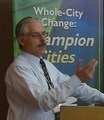PARTNERSHIP FOR WATER SUSTAINABILITY PASSES ECOLOGICAL ACOUNTING BATON TO VANCOUVER ISLAND UNIVERSITY: “EAP is cutting edge. It is innovative, very new and very unique. And it has the ability to really change the game,” stated Graham Sakaki, Regional Research Institute Manager

“The EAP Partnership was set up in a really unique, really valuable and viable way right from the beginning. The Partnership for Water Sustainability made the connections to the three local governments. Vancouver Island University, as a smaller university, is very focused on applied research and community engagement. This is a good fit for the EAP mission. There are lots of partnerships that exist for selfish reasons. But the EAP Partnership is selfless, and from all angles. It is a leap of faith for member local governments. Partnership for Water Sustainability commitment to passing the baton is unwavering,” stated Graham Sakaki.










